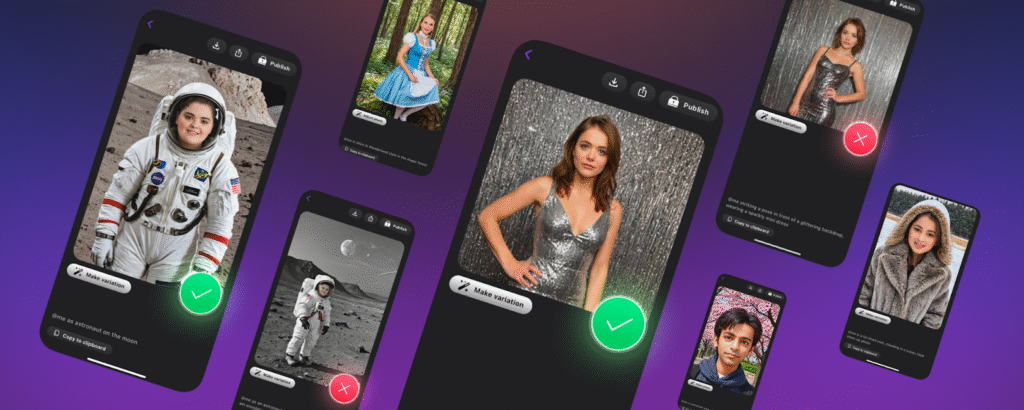Alright, I need to be brutally honest here. I’ve been neck-deep in AI image generation tools for almost seven years now, and the vast majority are complete steaming garbage. Overhyped marketing nonsense that promises revolutionary results but delivers absolute trash. But GenYOU from Generated Photos? It’s genuinely different. Not because it’s some mind-blowing innovation—it’s not—but because it solves legitimate problems that real businesses face every damn day.

What GenYOU Accomplishes (No Marketing BS)
Here’s what makes GenYOU brilliant: it’s incredibly dull, and that’s precisely why it works so well. While every other AI tool is frantically trying to generate flying purple elephants or abstract masterpieces or whatever trending garbage gets clicks, GenYOU focuses on one simple thing: creating realistic human portraits. That’s it. Nothing else.
The underlying technology uses generative adversarial networks. Sounds ridiculously complex, but it’s essentially two AI systems beating each other up digitally. One generates fake faces, the other tries to catch the fakes. After millions and millions of rounds, you get a system that’s surprisingly excellent at creating convincing human faces.
You can manipulate age, ethnicity, gender presentation, hair color, facial hair, accessories—essentially everything you’d control in a traditional photo shoot. But here’s what genuinely amazed me: the controls function properly. I’ve tested probably eighty AI tools where the settings work more like polite suggestions than real commands. GenYOU delivers what you request, most of the time.
Real Businesses Seeing Real Results
Marketing Teams Are Secretly Hooked
I grabbed coffee with a marketing director from a fintech company in Seattle ten weeks ago. Her team was hemorrhaging cash—$35,000 quarterly on stock photos and custom photography sessions. That’s $140K annually for images that looked identical to every other financial services company’s marketing.
“We needed authentic, diverse faces for our customer success sections,” she explained while picking at her croissant. “Stock photos made our testimonials look completely manufactured. Worse, we kept discovering the same models appearing on competitor websites. Builds confidence with potential clients, doesn’t it?”
GenYOU completely transformed their approach. Instead of coordinating massive, expensive photo productions, they generate portraits on demand. Need a testimonial from a 37-year-old financial advisor in Phoenix? Generate it instantly. Writing about investment apps for millennials? Create the perfect representative in seconds.
The cost reduction is insane, but the creative freedom is what hooked her team. They can now experiment with different demographic representations without obliterating their entire quarterly budget.
“Three weeks ago, we tested ten different age demographics across our email marketing campaigns,” she said. “Traditional photography would’ve required $30,000. With GenYOU, it cost us $61.”
UX Designers Found Their Holy Grail
A lead UX designer at a healthcare startup in Atlanta shared his biggest recurring nightmare: developing realistic user personas without accidentally appropriating real people’s photographs.
“I used to waste entire weeks browsing through massive stock photo libraries,” he told me during our Slack conversation. “Frantically searching for faces that aligned with our extensive user research data. Then I’d stress about accidentally using identical photos that appeared in competitor pitch presentations.”
GenYOU eliminated this headache. He generates precisely the person he needs for each persona—exact age ranges, professional styling, diverse ethnic backgrounds. The faces feel authentic enough for executive presentations, but avoid the legal nightmares of real people’s likenesses.
His design team now builds consistent character representations across every deliverable. When presenting user experience journeys, identically generated faces appear throughout complete presentations, establishing narrative consistency that random stock photos never achieved.
“My creative director used to joke that our personas looked like a chaotic assortment of professional networking profiles,” he laughed. “Now they function as believable characters.”
Content Creators Are Making Real Progress
A fitness blogger with 520K monthly subscribers described her ongoing challenge: locating authentic imagery that genuinely represents her incredibly diverse readership.
“Stock photos in the fitness industry are horrendous,” she said frankly during our phone interview. “Either they’re staged workout poses with people who look like professional athletes, or they’re identical recycled faces appearing across every fitness website online.”
She discovered GenYOU through a content creators’ Discord server. Now she generates custom portraits that perfectly align with her article topics—writing about strength training for busy professionals? Generate that exact demographic. Discussing nutrition for working parents? Create precisely that audience.
The authenticity response completely surprised her. “My subscribers started commenting that they could recognize themselves in my fitness content. That never, ever happened with stock photography.”
She shared comparison examples during our conversation. The difference was dramatic. Her previous articles featured obvious stock photos that screamed “GENERIC FITNESS MODEL.” Her current content showcases portraits that appear like genuine community members.
What grabbed my attention was her mention of using the central ai portrait generator platform for creating diverse fitness content. “The core platform gives me everything I need for authentic representation,” she explained. “Perfect for fitness content that needs to feel relatable rather than intimidating.”
E-commerce Operations Are Tracking Measurable Impact
A brand marketing coordinator at an online home decor retailer outlined his challenge. Nothing revolutionary about the business, but they serve customers aged 26-72. The issue was that their lifestyle photography overwhelmingly featured younger demographics.
“We were systematically losing mature customers because they couldn’t see themselves reflected in our brand imagery,” he explained. “But organizing photo shoots covering all demographic segments was logistically insane and financially devastating.”
GenYOU empowered its team to generate representative models across its complete customer demographic spectrum. They created portraits for different ages, ethnicities, and lifestyle preferences and integrated these into product styling and marketing materials.
The results were quantifiable and impressive: conversion rates increased 48% among customers over 53, and support tickets about “age-appropriate home decor” dropped significantly.
“For the first time in ten years, our mature customer demographic felt genuinely represented in our visual branding,” he said. “You can’t quantify that emotional connection in analytics reports, but it manifests in quarterly sales figures.”
The Technical Reality (Absolutely Zero Sugarcoating)
GenYOU operates exceptionally well within defined parameters. The portraits appear convincing, resolution satisfies professional requirements, and generation speed remains acceptable. But let’s be completely realistic about genuine limitations.
The platform excels at standard portrait formats—corporate headshots, customer testimonials, and fundamental character illustrations. It struggles noticeably with complex positioning, dramatic lighting scenarios, or highly stylized artistic photography. Need editorial fashion imagery or artistic portraits? You still require human photographers. Period.
The faces are completely synthetic, which raises interesting authenticity considerations. Legally, you’re entirely protected (these people don’t exist), but specific audiences might respond negatively if they discover the imagery is AI-generated. Context matters tremendously here.
I spent nine weeks extensively testing, generating over 2,400 portraits across various demographics and use cases. Quality remains consistently high, but you’ll occasionally encounter images that feel slightly “incorrect”—typically in facial expressions or eye contact authenticity. Not disqualifying, but requires careful selection.
Strange discovery: the system sometimes produces faces that appear too flawless. Like, disturbing uncanny valley territory. I began deliberately selecting slightly imperfect results because they felt more authentically human.
Integration Experience (From Someone Who Actually Lives This)
GenYOU’s API capabilities impressed me significantly more than the standard user interface. Organizations can integrate portrait generation directly into existing content management workflows or marketing automation systems. This functionality genuinely revolutionizes how companies approach visual content development.
The web interface is practical but completely unremarkable. Accomplishes the objective without being particularly elegant or inspiring. For teams regularly generating portraits, the straightforward controls are superior to unnecessarily complex creative applications.
I observed the Seattle marketing team utilize it during a live strategy development session. They generated 38 different portrait variations in approximately 55 minutes. Try achieving that timeline with traditional photography coordination.
The Ethics Complexity (Yeah, It’s Messy)
Implementing AI-generated imagery isn’t simply a technical choice—it’s fundamentally an ethical decision. While GenYOU produces entirely synthetic faces, transparency regarding content origins is becoming increasingly critical in public discourse.
I’ve witnessed various organizations handle disclosure requirements differently. Some clearly label all AI-generated content, others seamlessly integrate it without explicit disclosure. The strategy usually depends on industry regulations, audience expectations, and fundamental brand principles.
The platform’s terms comprehensively address commercial usage scenarios, but organizations should establish detailed internal guidelines for AI-generated content implementation. What seems socially acceptable currently might not be in seven years as public awareness continues to develop.
My genuine perspective? Be transparent when it authentically matters, but avoid overthinking every single application. These faces don’t represent actual people, so you’re not exploiting real individuals’ likenesses. However, if your brand emphasizes authenticity above everything else, seriously reconsider.
Where This Technology is Moving
GenYOU represents the early stages of a fundamental transformation in visual content creation approaches. The core technology will undoubtedly improve, with enhanced resolution capabilities, more realistic facial characteristics, and expanded customization features. But the more significant change is entirely cultural.
We’re rapidly transitioning toward a reality where synthetic imagery becomes standard practice across all industries. GenYOU serves as a crucial component of that evolution, providing professional-grade solutions for organizations prepared to adopt AI-generated visual content.
The question isn’t whether this technology will achieve mainstream adoption—it’s already achieving mainstream adoption. The actual question is how rapidly individual businesses will modify their established workflows to utilize these emerging capabilities effectively.
My Honest Evaluation
GenYOU addresses specific business challenges exceptionally well. It’s not revolutionary or groundbreaking, but it’s professionally dependable and commercially practical for real-world implementations. For marketing departments, UX design teams, content creators, and e-commerce operations, it provides genuine value through substantial cost reductions, enhanced creative flexibility, and improved demographic representation.
The platform certainly won’t replace all traditional photography applications, but it doesn’t need to achieve that goal. It effectively fills a particular niche—professional portrait generation—with sufficient quality and convenience to warrant widespread implementation.
If you’re currently evaluating AI portrait generation solutions for your organization, GenYOU merits serious consideration. Not because it’s flawless or perfect, but because it operates reliably within its established parameters. In the rapidly evolving environment of AI-generated content, operational dependability is worth significantly more than flashy features.
The future of visual content creation is undeniably synthetic. GenYOU provides a practical, reliable entry point into that emerging reality, with both advantages and limitations clearly understood. Whether that technological future energizes or worries you is ultimately a strategic decision each organization must resolve independently.
But honestly? After seven years of testing overhyped AI tools that promise revolutionary breakthroughs and consistently underdeliver, discovering one that performs precisely as advertised feels genuinely refreshing.
Source: https://baddiehub.news/






